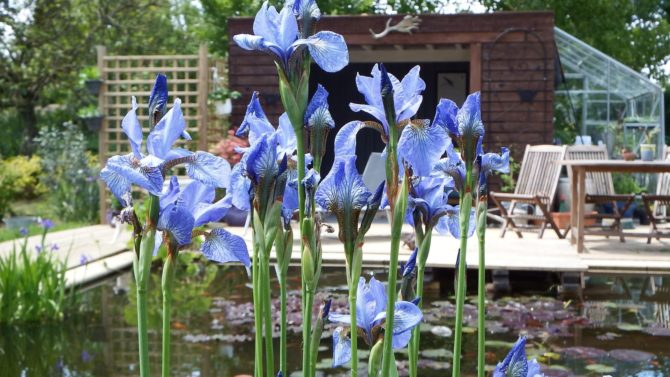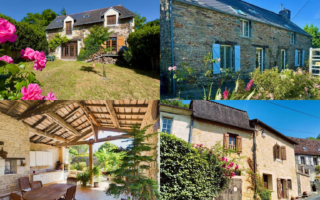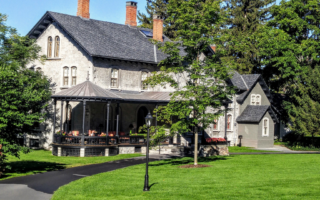Should you build a pond on your French property?
A dragonfly flits across the water making tiny ripples as it goes. Below the surface, orange flashes are evidence of fish tails swishing, while a keen ear can pick out insects buzzing and perhaps the occasional croak of a frog or toad. A microcosm of the natural world, a pond is a place for plants and wildlife to thrive together, and all just steps from your front door.
Ponds may be more commonly found in the gardens of English homes than French ones, but they can be easily designed and built to fit your space and resources in France, and they are great if you are looking to be more eco-friendly. According to the UK’s Wildlife Trusts, a healthy pond likely to support a greater range of wildlife than any other feature. The organisation says that even the smallest of ponds can offer a home to dragonflies and newts, while ponds can also be a feeding ground for birds and bats.
Any garden
If you already have a French property, you could start planning and preparing your bassin anytime. If you are still on the hunt for your piece of France, it could be an element to keep in mind when exploring gardens on any upcoming house viewings. A small pond can fit in almost any garden but you may want to consider which areas you could use for it, or if you don’t fancy building one yourself you might be able to seek out a ready-made pond to enjoy.
In Cheffois, Pays de la Loire, former landscape manager and sled dog racer Jim Bryde and his partner Cherry Burton, a landscape designer, have combined their skills to create a beautiful water feature in their garden. When moving to France, people will often bring along their pet dog or cat but when Jim and Cherry made the move, they brought along a container of Koi and goldfish. For the journey across the Channel, the fish were put in a polythene bag that had been pumped with water and oxygen and stored in a polystyrene box – a method that Jim says could keep the fish happy for a week.

Fishy business
Upon arrival in France, Jim created a relatively small 2x2m pond in their front garden that the fish could be transferred into. Once this was created, they decided they wanted something bigger and better so they found a large spot in the back garden and, with a bit of time, elbow grease and recycled materials, they built their square 6x6m pond along with a planting bed, summer house and decking area.
Acers and spades
Experienced gardener Cherry chose the plants for their new garden feature but before this it had to be built, and that was Jim’s job. First consideration was how to level the land as their garden was on a slope. Jim decided to dig down to make the pond and then use the excavated soil to flatten out the surrounding areas.
Step one was to build the L-shaped planting beds which would be filled with acers and moisture-loving plants and which would also act as a retaining wall for the pond. On the outer edge was an 46cm-high drystone wall and then, a metre inside, a parallel block retaining wall. Handily, their neighbour was pulling down a barn at the same time and gave them stone from the barn in exchange for help putting up a new roof.
With just a spade and a wheelbarrow, Jim dug out around 30m3 of soil for their 1.2m-deep pond over the winter. “It didn’t take long,” Jim explains, “because it’s very good soil where we are. I didn’t hit any stone when I was digging it out.”
While ornamental ponds can be much shallower than this, Jim recommends making it at least 70-80cm deep, especially if you want to keep fish, because winter frosts and summer heat drying out the ponds can both be risks to the wildlife in there.

Once the pond was dug, Jim took the opportunity on a trip back to England to pick up a Firestone pond liner from a company that had an offer on for the liner and a felt underlay. With the liner in, it was time to turn on the hosepipe and fill up the almost 50,000-litre pond, which took a full day. Then he added some paving slabs around the edges and the basic pond was complete.
Circle of life
Since then, Jim has also installed a pump and filtration unit with ultraviolet light which keeps the water clear. He also has to regularly thin out the pond weed which he had added in for oxygenation. Jim tells me that as soon as the pond was filled, he had taken some of the weed from the existing front garden pond and added it to the new pond along with some lilies. What he didn’t realise was that he had brought something else over too.
“Two weeks later, I said ‘oh look, what’s that cloud of red down there?’ The pond weed I’d thrown in was full of eggs from the fish I’d brought from England. There must be 200-300 fish in there now, not one of them I bought; they all just came from eggs from the other pond. I’ve got that many fish I’ve been trying to give them away,” he says.

As well as the thriving fish there are also three cats and two dogs – a Siberian Husky and a Yakutian Laika – living on the property, all of which are very well behaved and know not to go into the pond. What has been causing a nuisance in the habitat, however, is a whip snake. They aren’t poisonous to humans but can feed on frogs and one has been using the pond as a “live sushi bar”, Jim says. “I saw one go in head first, open his mouth and grab a fish!”. The summer house has also attracted nesting swallows; hedgehogs visit the garden and herons fly overhead. “A heron tried coming down to eat the fish once but because the water is so deep, he can’t stand in it,” Jim explains.
As Jardins Ouverts/Open Gardens members, every spring Jim and Cherry invite visitors to buy a ticket to see their ponds and gardens and witness the active wildlife for themselves. Money raised by the association is given to charities for disabled and seriously ill children and young people in France.
Share to: Facebook Twitter LinkedIn Email
More in French Property News, Living in France, Renovating in France




